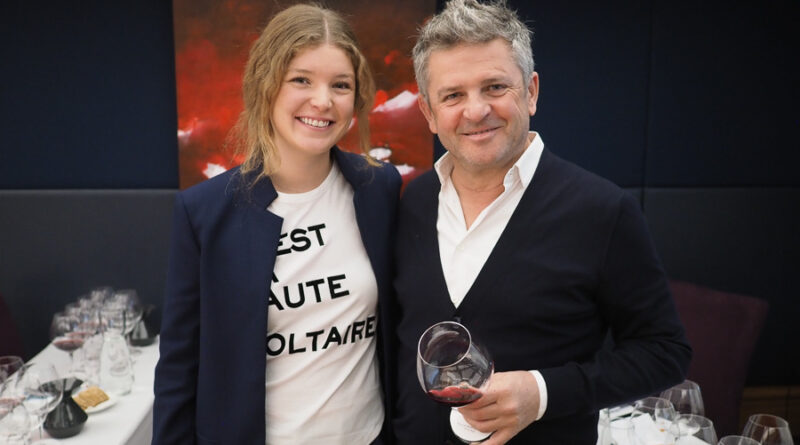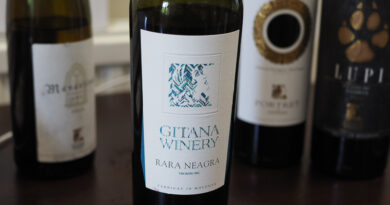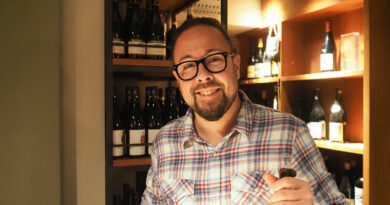The remarkable wines of Álvaro Palacios: Rioja, Bierzo and Priorat
Álvaro Palacios was in town with his daughter Lola, showing off his impressive portolio, which includes Palacios Remondo (Alfaro, Rioja), Álvaro Palacios (Alfaro, Rioja), Álvaro Palacios (Gratallops, Priorat) and Descendientes de J. Palacios (Curullón, Bierzo). Most of the focus was on the Rioja project, but we also tried the top wines from the other regions.
Lola, Álvaro’s only child (he was seventh of nine) has recently joined her dad after her studies and training, which included some very interesting vineyards. She studied three years in Bordeaux for three years, when she worked in the Rhône and Burgundy, and then Napa. ‘Now I’m happy to start working with Papa,’ she says. Before her formal wine studies, she had been working in the winery since she was 14, and did high school in the USA.

Palacios Remondo is the family winery in Alfaro, in the eastern side of Rioja. The winery was created in 1947 by his grandparents. Álvaro studied in Bordeaux, and worked in Petrus. ‘I became crazy about classic wine,’ he says. He came back to Rioja in 1987 as Spain was opening up to the world after being a bit isolated. ‘I saw new perspectives and moved to Priorat,’ he says, which left his father very disappointed. This was in 1989, when he was working with Christian Moieux in Bordeaux when at the age of 25: he got a call from Rene Barbier to come and join him in Priorat. So he sold his motorbike, borrowed a car and moved there. To fund himself he started selling barrels, and the first wine he made was a negociant wine called Les Terrasses. Priorat at the time was very depressed and the growers were typically paid for their grapes 2 years after vintage. He went to the cooperative and could choose whatever grapes he wanted. Over the next few years he created Priorat’s village system and helped revive this remarkable region from obscurity. He first bought the grapes for L’Ermita in 1993, and later bought the vineyard. It started off with 3 hectares; now he has 4.8 hectares.
Then a decade later after Priorat had taken off his nephew Ricardo moved to Bierzo in 1999. Álvaro’s father passed in 2000, and his mother and brothers asked him to come back to Rioja.
Rafael, his youngest brother, bought vineyards in Valdeorras, and has been really successful there.
The original Rioja vineyards are La Montesa, planted by his father and grandfather in the 1980s (between 1987 and 1989). These are up in the hills, and are the best vineyards of Rioja Orientale in the footsteps of the Sierras at 500-600 m. He’s now planting even higher, at 700 m. New plantings are bush vines at a density of 1.5 x 1.5 m, farmed with Burgundian tractors that go over the top of the rows. Rupestris du Lot is the rootstock of choice.
‘Spain was like little Burgundies,’ says Álvaro. ‘Every village had hundreds of vineyards. But there was a decline in the economy of rural areas in the early 20th century: we lost many Grand Crus, they were forgotten.’ The rural world wasn’t appreciated and the government put money into industry. In the 1940s many cooperatives emerged in the villages, and entrepreneurs created big wineries to absorb the grapes of the small vignerons.
‘My father was one of these,’ says Álvaro. ‘My grandfather had a lot of vineyards.’ Álvaro and his brothers got these vineyards back and began to work with them. These sites have soils from the quaternary era at the surface, and under this are soils from the tertiary. There is sand, silt and clay, with some iron in the clay, turning it red. And there are pebbles from the top of the mountain, too. These sites also have interesting horizons of calcium carbonate, which give vibrancy and freshness to the wines. There’s a 3 hectare plot called Valmira which Álvaro says is ‘touched by the divine hand’, where the calcium carbonate layer goes down 6 m.
Garnacha, the key grape of this area, can be capricious, with yield varying dramatically. ‘You can lose half the crop in a bad season,’ he says. Valmara can vary from 3000 to just 800 bottles.

When irrigation came growers planted Tempranillo, a shorter-cycle grape, which suits the Atlantic influenced sites, whereas Garnacha likes heat and drought. Tempranillo makes dark wines, which were in fashion for quite a while. The result has been that of 23 500 hectares of Rioja Orientale, just 4000 hectares of Garnacha are left.
In Rioja there Álvaro has 100 hectares, and half of this is Garnacha. There’s also Graciano and Mazuelo, but they are grafting over to Garnacha. With organics, it’s very hard to grow Mazuelo because of the mildew pressure. As well as these, they also have a little bit of old vine Bobal, Moristel, Tinta Velasco, Viura and Garnacha Roja (gris), which are all interplanted.
The older vineyards are double cordon, with 24 clusters per vine, so they drop crop. Bush vines are 9-16 clusters, and they’ve been planting these more recently. ‘If you go more than 4 tons/hectare with Garnache it gets diluted,’ says Álvaro, ‘which is why we adore bush vines for Garnacha.’
THE WINES

Álvaro Palacios Finca la Montesa 2021 Rioja, Spain
Álvaro is very excited about the 2021 vintage. ‘A fresh summer reminded me of the old days,’ he says. ‘2021 is the vintage to buy everywhere in Spain.’ Real intensity and depth here. Deeply coloured for Garnacha with a core of sweet cherry and raspberry fruit. Powerful and fine grained with good focus, and a silky texture. Enticing and pure with lovely weight. 96/100
Álvaro Palacios Finca la Montesa 2018 Rioja, Spain
Álvaro says that harvesting 100 ha by hand quickly is tricky, but by harvesting fast he can achieve lower alcohol. Each year 600-700 tons are hand harvested by 65 people, and it takes just 12 days. He also employs 30 people to work 3 sorting tables, and the grapes go to the fridge before he begins making the wines. 95% Garnacha, 5% field blend of traditional varieties, aged 12 months in barrel, after a 45-55 day maceration in tank, wild yeast ferment. 80% French oak, 20% American, with just a little new. For 2018 and 2019, all destemmed. 2020 was 20% whole cluster, but crushed. 2021 was 50% whole cluster. Bright, fresh and linear with perfumed red cherry fruit and some redcurrant. Midweight with a touch of oak. Very fine and linear with a sense of lightness and elegance. Juicy and distinguished with lovely finesse. 94/100
Álvaro Palacios Finca la Montesa 2019 Rioja, Spain
95% Garnacha. This was a dry year with just 350 mm rain. Lovely purity and intensity here with red cherries, a touch of liquorice and spice, some structure but also a lovely texture. Supple and fine with nice purity to the red cherry and plum fruit. Has polish but also freshness. Expressive and fine. 94/100
Álvaro Palacios Finca la Montesa 2020 Rioja, Spain
90% Garnacha. Lots of rain in spring this year. Quite deeply coloured for Garnacha with good structure and vibrant red cherry and raspberry fruit. There’s some grip under the textured fruit. Fine grained with beautiful fruit, finishing with nice acidity. This has ageing potential and is very stylish, finishing with a twist of orange peel. 94/100

Álvaro Palacios Quiñón de Valmira 2021 Rioja, Spain
This is from a windy 3 ha plot at 600 m, with distinctive soils: they are white with 6 m deep calcium carbonate. Bush vines at 1.7 x 1.7 m planted in 1980. Originally this was 80% Tempranillo, but this has been grafted over to Garnacha, which makes up 85% of the blend, with the remainder other traditional varieties. This has depth but also amazing freshness with elegance and structure. Nice bright red cherries with notes of aniseed and spice. Such precision and purity here with nice detail and finesse. Lovely complexity and freshness with astonishing texture, which really sets this wine apart. 97/100

Álvaro Palacios L’Ermita 2021 Gratallops, Priorat, Spain
14% alcohol. Initially Álvaro began ageing this wine (he first made this in 1993) in small oak, but it is not good for Garnacha, so he now uses foudres. The blend in 2021 is 76% Garnacha, 23% Cariñena and 1% white varieties. Fresh, taut and linear with compact red cherry and berry fruit. Floral, mineral and fine. There’s a nice tannic structure here under the very fine red fruits, with hints of liquorice, aniseed and wet stones. Very fine with lovely purity and finesse, this has the potential for long ageing, even though it is approachable now despite the substantial structure. 97/100

Descendientes de J Palacios La Faraona 2021 Corullón, Bierzo, Spain
13.5% alcohol. Pure Atlantic climate. 950 m altitude, facing east, thick schist soils. Mencia with 5% other varieties including some white. Ripe and vivid with nice intensity, showing sweet black cherry and blackberry fruit, with nice fine tannins. Substantial and pure, showing finesse to the sweet black fruits, and grainy mineral structure. This shows ripeness but also finesse and purity, with a hint of dairy in the background. 95/100
Older notes, from the 2020 vintage release. These notes are from small bottle samples, tasted on two separate occasions.
Descendientes de J. Palacios, Corullón, Bierzo
2020 Villa de Corullón
Very floral. Lovely concentrated, fresh, sweet cherry and raspberry with good texture and density. Has nice crunchy tannin, but the emphasis here is sweet elegant fruit with fine hints of tar and spice. Lovely stuff: I’m really impressed by this. 94/100
2020 Las Lamas
One of the single parcels, 750 m, schist and clay, steep slopes. Vibrant, assertive nose with tar and spice, some minerals, and black cherry notes. The palate has great concentration but also freshness with sweet cherries and plums, and a wonderful savoury spiciness. Complex, structured, with a fabulous depth and complexity, and a touch of wildness. This is thrilling. 97/100
2020 Moncerbal
Seven small parcels, fermented on stems. Some sappy hints on the nose with refined red cherry and plum fruit. The palate is intense and compact, with some green sappy hints, a touch of undergrowth and some lovely sweet cherry and plum fruit. There’s latent potential here with lovely taut fruit, although it’s fully ripe. 94/100
2020 La Faraona
This comes from a half-hectare plot at 750 m altitude, in a vineyard on a geological fault. Some of the vineyard has soft slate and clay, but this portion has very hard slate oriented horizontally, without the usual vertical fissures that allow the roots to penetrate. The result is very small clusters of grapes, and because it’s south east facing it gets the white light of the morning. The result is incredible. This is taut and reductive on the nose, and the reduction is quite prominent, and there are notes of iron, blood and dried herbs. On the palate this is concentrated and vivid with good acid and structure, and linear black cherry and berry fruits, with a vital undercurrent of minerals and dried herbs, with firm tannins and good acidity. Has a real freshness and lots of latent potential. After a while it opens out to reveal lavender and fennel too. 96/100
Álvaro Palacios, Gratallops, Priorat
2020 Gratallops
This is the village wine. Very floral on the nose with sweet cherries and raspberries, and a floral lift. Lots of raspberry here. The palate is really fruit-focused with liqueur-like cherry fruit and some appealing herbal characters. This is a beautiful wine with lots of fruit, and a touch of aniseed, too. 94/100
2020 Finca Dofi
Sweet black cherry fruit with some spice and tar notes on the nose, adding some savoury buttressing to the seductive floral fruit. The palate has lovely crunch with some grippy tannins sitting under the sweet, pure black fruits, and also some red fruit freshness, too. This has such good balance and concentration. 95/100
2020 La Baixada
There’s a touch of olive and walnut on the nose here with some sweet berry fruits. The palate is sweet and savoury, with lovely dried herb and olive complexity as well as vital cherry fruit, backed by good acidity and structure. There’s some sour cherry on the finish. This is so beautiful and expressive. 96/100
2020 Les Aubaguetes
Concentrated and dense with floral black cherry and plum fruit. It’s tight wound: there’s ripe fruit, but also good structure and intensity. Very expressive with a lot of potential for development. This is really structural. 95/100
2020 L’Ermita
Intense, brooding, sweet blackcurrant and cherry fruit nose with some liqueur-like richness but also savouriness. The palate is ripe, dense and concentrated with firm tannins and a fine spiciness. It’s rich and dense, a bit salty, with a meaty broth quality under the fruit and also some dried herbs. Finishes fresh and taut. This is immense, and has a long future ahead of it. I love the way it is fully ripe but avoids any trace of over-ripeness. 97/100
Álvaro Palacios, Alfaro, Rioja
2020 Quiñon de Valmira
100% Grenache. Floral with some tarry, spicy, peppery notes. The palate is ripe, sleek and delicious with blackcurrant and cherry fruit, a touch of cedar spice, some raspberry crunch and wonderful balance. It’s sleek and seductive but also quite serious, with potential for development. Incredible stuff. 95/100




